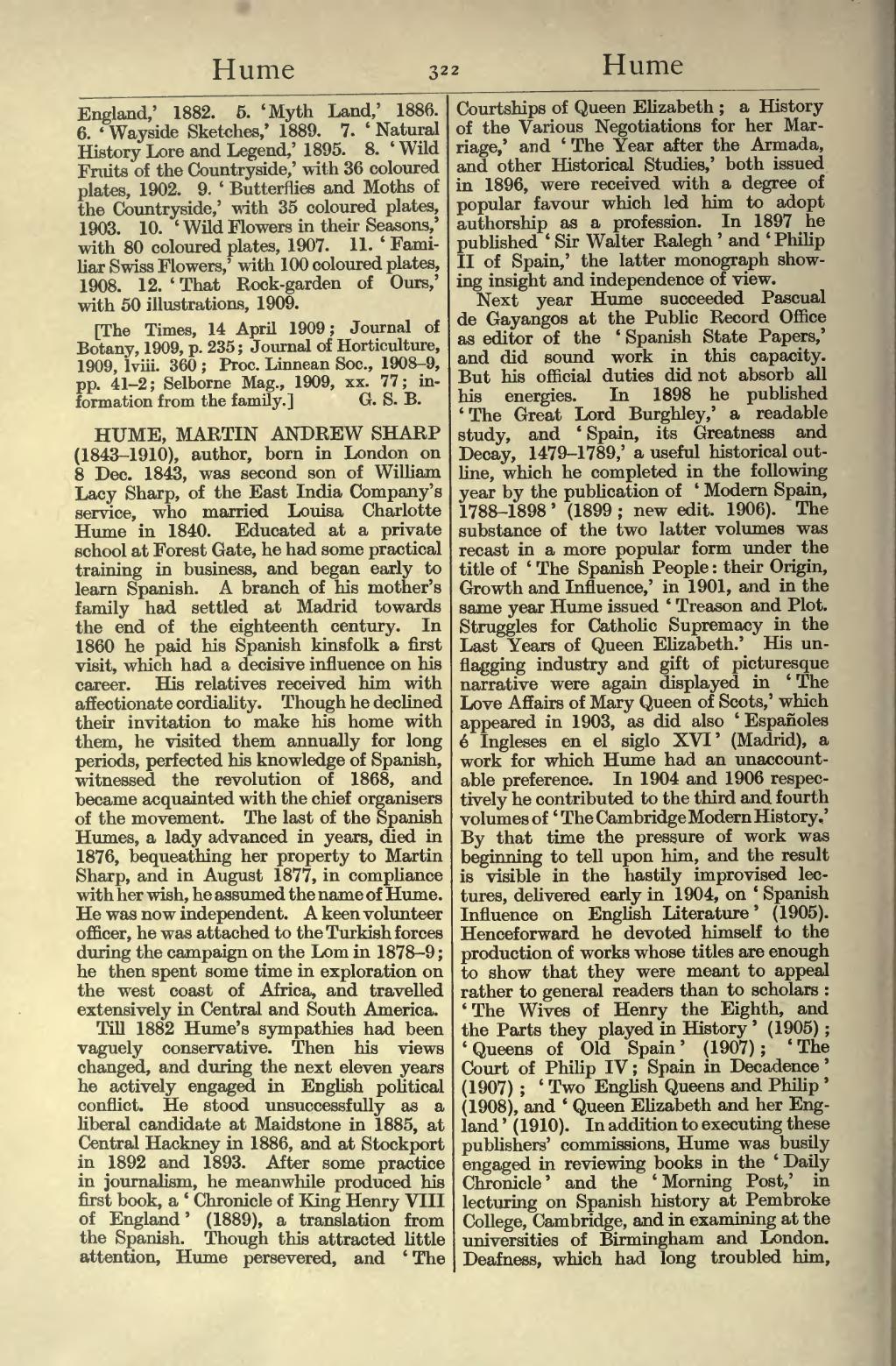England,' 1882.
- 'Myth Land,' 1886.
- 'Wayside Sketches,' 1889.
- 'Natural History Lore and Legend,' 1895.
- 'Wild Fruits of the Countryside,' with 36 coloured plates, 1902.
- 'Butterflies and Moths of the Countryside,' with. 35 coloured plates, 1903.
- 'Wild Flowers in their Seasons,' with 80 coloured plates, 1907.
- 'Familiar Swiss Flowers,' with 100 coloured plates, 1908.
- 'That Rock-garden of Ours,' with 50 illustrations, 1909.
[The Times, 14 April 1909; Journal of Botany, 1909, p. 235; Journal of Horticulture, 1909, lviii. 360; Proc. Linnean Soc, 1908-9, pp. 41-2; Selborne Mag., 1909, xx. 77; information from the family.]
HUME, MARTIN ANDREW SHARP (1843–1910), author, born in London on 8 Dec. 1843, was second son of William Lacy Sharp, of the East India Company's service, who married Louisa Charlotte Hume in 1840. Educated at a private school at Forest Gate, he had some practical training in business, and began early to learn Spanish. A branch of his mother's family had settled at Madrid towards the end of the eighteenth century. In 1860 he paid his Spanish kinsfolk a first visit, which had a decisive influence on his career. His relatives received him with affectionate cordiality. Though he declined their invitation to make his home with them, he visited them annually for long periods, perfected his knowledge of Spanish, witnessed the revolution of 1868, and became acquainted with the chief organisers of the movement. The last of the Spanish Humes, a lady advanced in years, died in 1876, bequeathing her property to Martin Sharp, and in August 1877, in compliance with her wish, he assumed the name of Hume. He was now independent. A keen volunteer officer, he was attached to the Turkish forces during the campaign on the Lom in 1878-9; he then spent some time in exploration on the west coast of Africa, and travelled extensively in Central and South America.
Till 1882 Hume's sympathies had been vaguely conservative. Then his views changed, and during the next eleven years he actively engaged in English political conflict. He stood unsuccessfully as a liberal candidate at Maidstone in 1885, at Central Hackney in 1886, and at Stockport in 1892 and 1893. After some practice in journalism, he meanwhile produced his first book, a 'Chronicle of King Henry VIII of England' (1889), a translation from the Spanish. Though this attracted little attention, Hume persevered, and 'The Courtships of Queen Elizabeth; a History of the Various Negotiations for her Marriage,' and 'The Year after the Armada, and other Historical Studies,' both issued in 1896, were received with a degree of popular favour which led him to adopt authorship as a profession. In 1897 he published 'Sir Walter Ralegh' and 'Philip II of Spain,' the latter monograph showing insight and independence of view.
Next year Hume succeeded Pascual de Gayangos at the Public Record Office as editor of the 'Spanish State Papers,' and did sound work in this capacity. But his official duties did not absorb all his energies. In 1898 he published 'The Great Lord Burghley,' a readable study, and 'Spain, its Greatness and Decay, 1479-1789,' a useful historical outline, which he completed in the following year by the publication of 'Modern Spain, 1788-1898' (1899; new edit. 1906). The substance of the two latter volumes was recast in a more popular form under the title of 'The Spanish People: their Origin, Growth and Influence,' in 1901, and in the same year Hume issued ' Treason and Plot. Struggles for Catholic Supremacy in the Last Years of Queen Elizabeth.' His unflagging industry and gift of picturesque narrative were again displayed in 'The Love Affairs of Mary Queen of Scots,' which appeared in 1903, as did also 'Españoles é Ingleses en el siglo XVI' (Madrid), a work for which Hume had an unaccountable preference. In 1904 and 1906 respectively he contributed to the third and fourth volumes of 'The Cambridge Modern History,' By that time the pressure of work was beginning to tell upon him, and the result is visible in the hastily improvised lectures, delivered early in 1904, on 'Spanish Influence on English Literature' (1905). Henceforward he devoted himself to the production of works whose titles are enough to show that they were meant to appeal rather to general readers than to scholars: 'The Wives of Henry the Eighth, and the Parts they played in History' (1905); 'Queens of Old Spain' (1907); 'The Court of Philip IV; Spain in Decadence' (1907); 'Two English Queens and Philip' (1908), and 'Queen Elizabeth and her England' (1910). In addition to executing these publishers' commissions, Hume was busily engaged in reviewing books in the 'Daily Chronicle' and the 'Morning Post,' in lecturing on Spanish history at Pembroke College, Cambridge, and in examining at the universities of Birmingham and London. Deafness, which had long troubled him,
